Smith & Wesson’s M&P Shield is an iconic pistol. The subcompact Shield is one of the most popular handguns on the market today. I carried a Shield 2.0 as my primary EDC handgun for a little under a year, and statistically many of you reading this have owned or carried one at some point, too. I am a big fan of the Shield but I think the best of the bunch has been completely ignored.
This article contains affiliate links.
I teased this article several months ago. Some of you have written into ask about it, and there are dozens of instances of “Shield” in the list of terms searched on the site. Today I offer you a review of one of the best, most overlooked Shield models: the long-slide Shield. The long-slide Shield is nothing more than a Shield 2.0 with a longer, 4-inch barrel. In my opinion it is more than the sum of its parts.
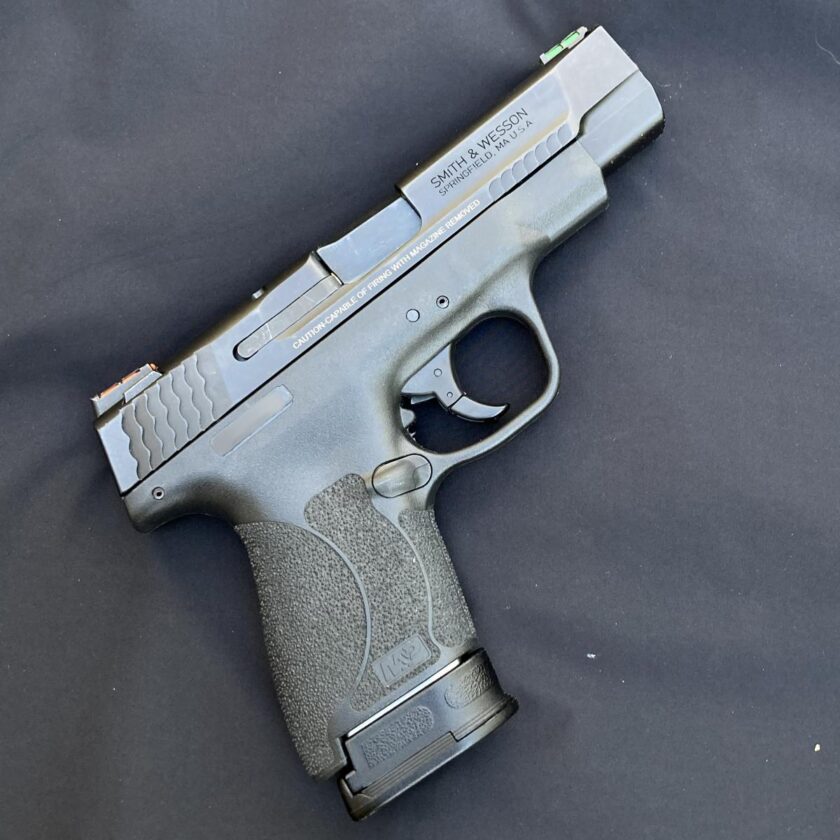
The M&P Shield
Before we get into it, the regular, old M&P Shield deserves just a bit of attention here. They’re so common – over 3,000,000 sold – it’s easy to sort of overlook them. Everyone has one and they just kind of become the background. The Shield is an extremely important pistol, thought. It was to carry handguns what Nirvana’s album, Nevermind was to rock and roll: a total and complete game-changer. The Shield is representative of an entire generation of slim-line, pocket-sized, duty-caliber handguns that actually work and are actually shootable. Though it hasn’t even been around for ten years yet, the Shield is one of the most popular concealed carry pistols in existence.
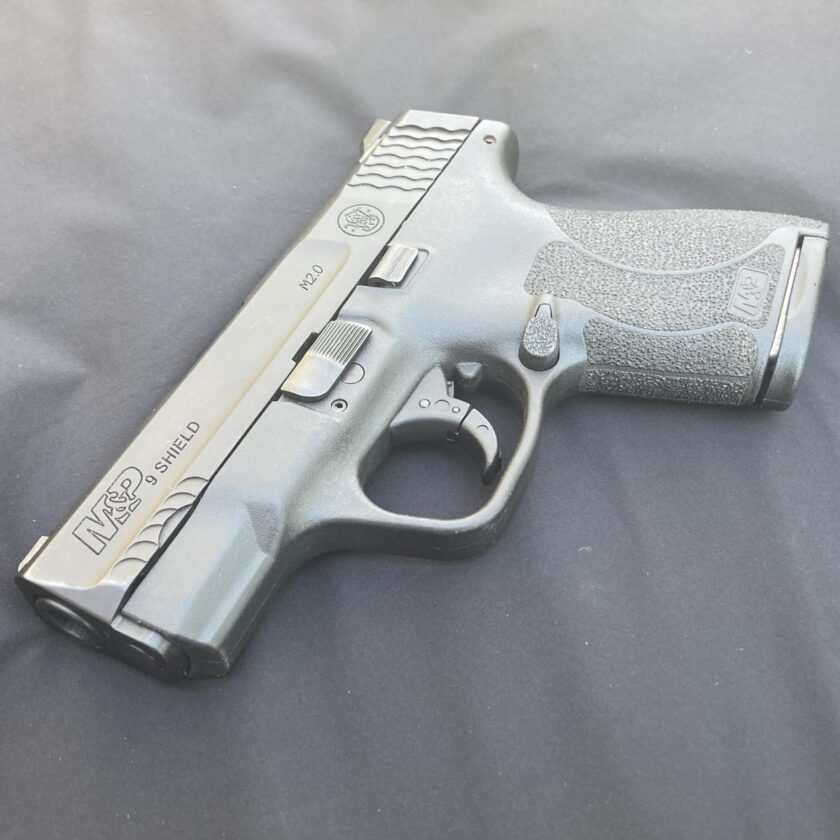
The M&P Shield is an outstanding pistol, and not just because of its size. Though a bit snappy (in 9mm – I haven’t bothered with .40 or .45 versions) it’s not uncomfortable to shoot. It shoots exceedingly accurately, and has a trigger that easily bests its bigger brothers in the M&P lineup. The Shield is about as reliable as a handgun can be – I’ve got 1,500 rounds on mine without the first hiccup. And despite all this it is extremely compact; it fits into the same size category as a J-Frame revolver, yet it is easier to shoot well, faster to reload, and shoots cheaper, more highly developed 9mm ammo. If that’s not enough, it also manages to hold 7+1 rounds of 9mm inside its tiny grip frame, and is about as affordable as any high-quality pistol on the market.
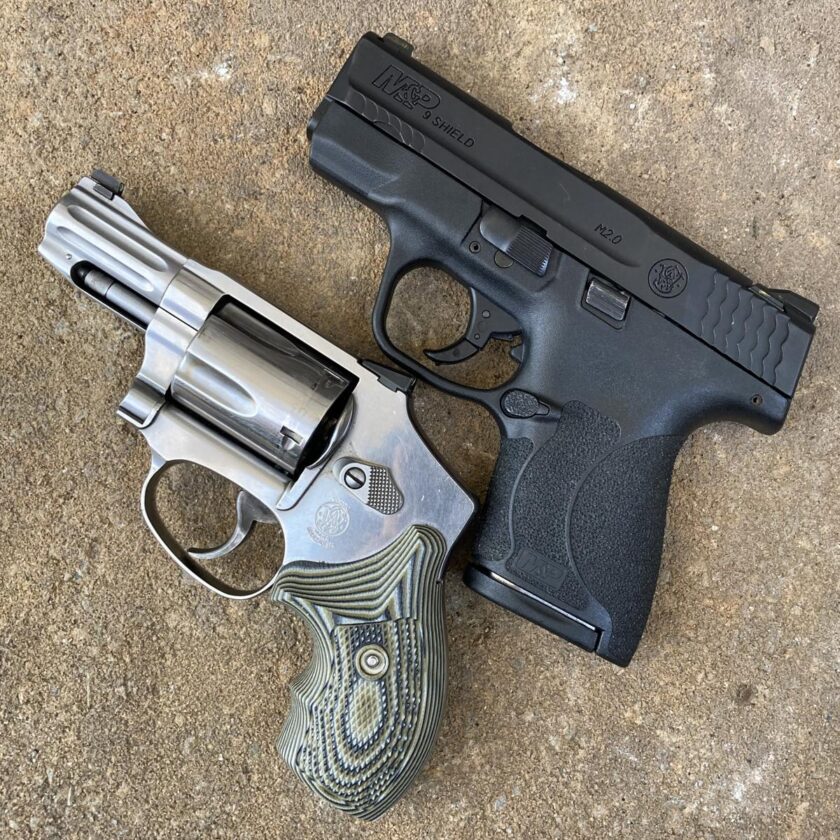
All that probably doesn’t seem to impressive right now. The Shield represents “Gen One” of truly viable, ultra-compact pistols. The Sig P365 ushered in “Gen Two” – a crop of tiny guns that cram in even more ammo (one of which is the 10+1/13+1 Shield Plus), and shoot and feel maybe even a little better. All that is just to remind you – and myself – that the standard Shield is only outclassed by comparison. It’s easy to look at guns that do more and focus on the unfavorable comparison, but on its own merits the single-stack, 7+1 M&P Shield is still a heck of a pistol†.
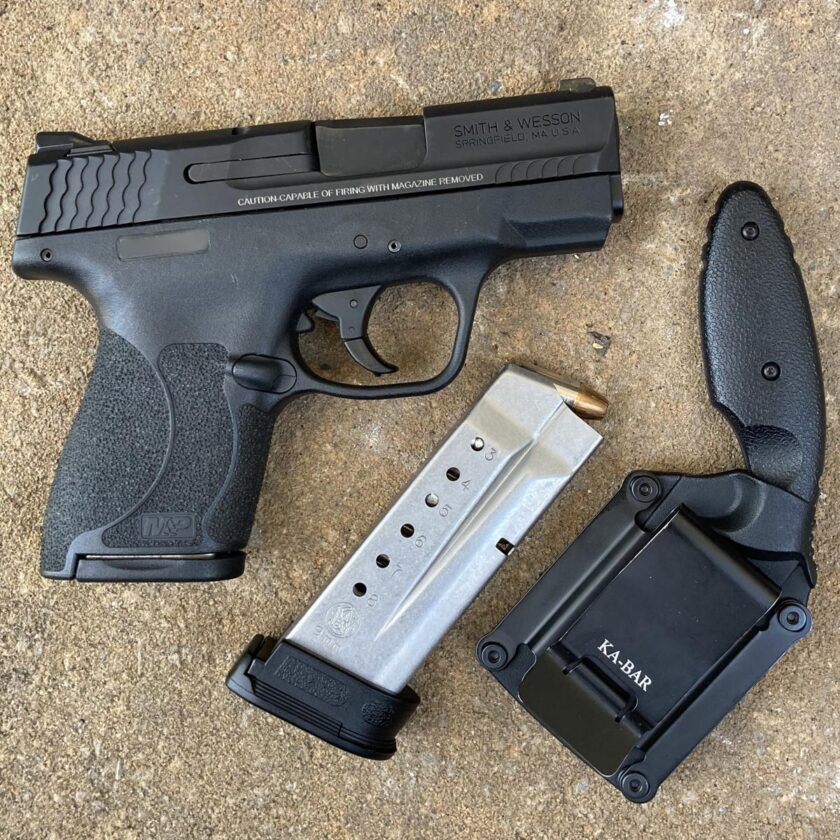
But it gets even better…
The Long-Slide Shield
For quite some time I have been interested in a Shield with a longer slide. I once heard Karl Rehn on a podcast talk about his Shield, and indicate that he modified it with a longer, threaded barrel (I sure wish I could find that podcast)(I got in touch with Karl just hours after this article published; here is an article about his modified Shield). Onto the barrel he affixed a slight block to which he mounted his front sight. This accomplished several things: it gave the gun an extra inch or so of sight radius, the longer tube boosted velocity a bit, and it put a bit more weight forward which further helped dampen recoil. I was very interested in this but switched carry guns before I got around to modding my Shield’s slide in a similar fashion.
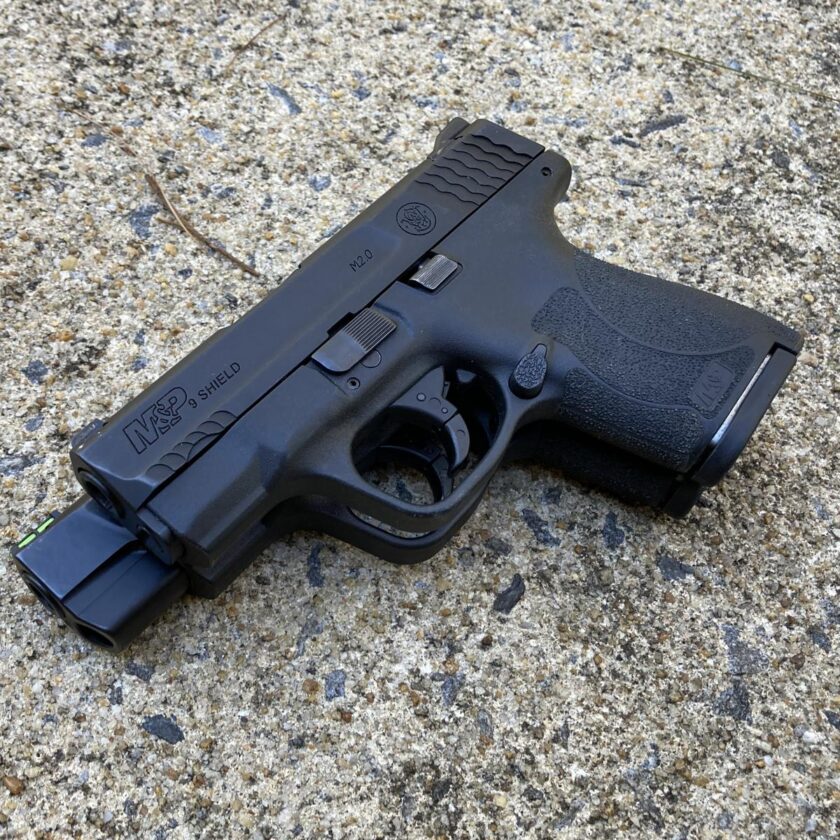
However, a year or so ago I noticed a long-slide, Performance Center version of the M&P Shield in S&W’s catalog. It was the same Shield, but with a lengthened slide. I wasn’t quite sure what it would do for the gun’s performance, but it sure made it look a little less snubby and a little more balanced. I reached out to my contact at S&W and asked if I could borrow one for this review. The answer was in the affirmative…but that was just days before the COVID gun/ammo sales boom kicked off. I had to wait several months, but the long-slide Shield finally arrived at my local gun shop in late November.
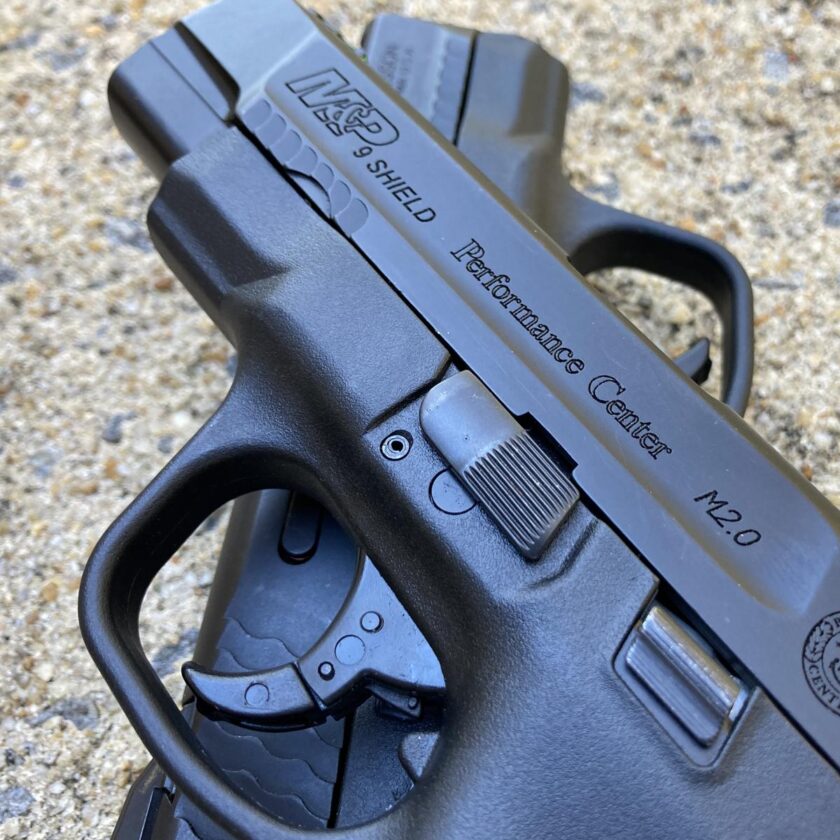
The long-slide Shield is more technically the “Performance Center® M&P®9 Shield™ M2.0™ 4″ Barrel” (for obvious reasons I’ll just refer to it as the long-slide Shield). It comes in a couple variations and with a number of options. The long-slide Shield is available with or without a thumb safety, an optic cut, comes with night- or fiber-optic sights, and with a standard or ported barrel. It also comes in your choice of caliber: 9mm, .40 S&W, and .45 ACP. Additionally, all PC models also feature a tuned action. Interestingly, the new 10+1/13+1 Shield Plus is also available with a long slide – I think that is going to be a heck of a pistol.
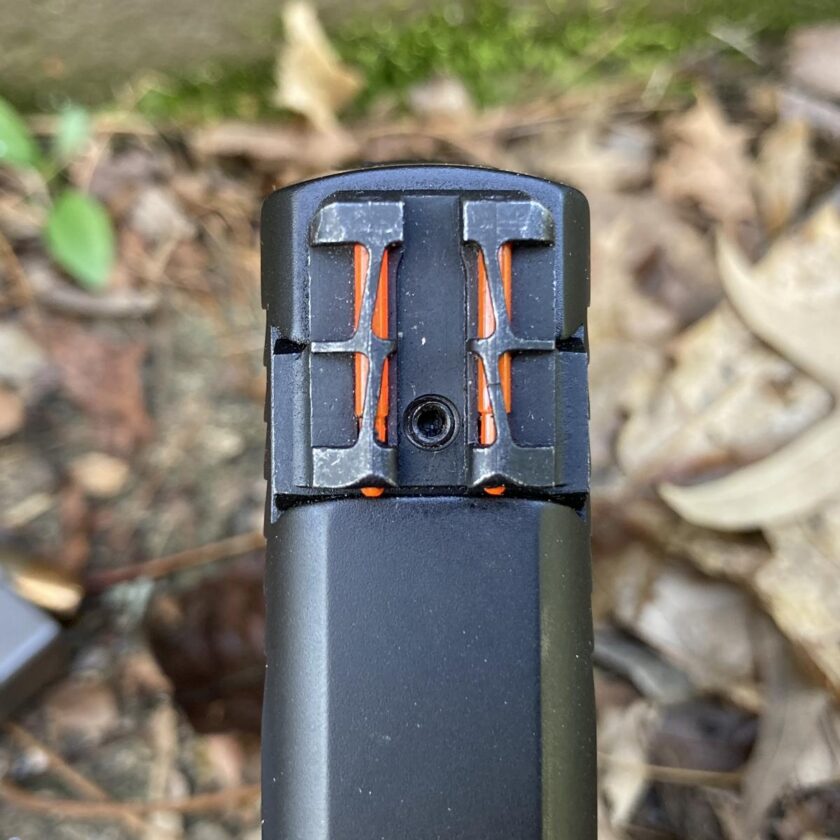
The exemplar shipped to me was about as plain as they get; it had a no safety, no optic cut, fiber sights, a plain barrel, and was chambered in 9mm Luger. Being a Performance Center model it does boasts a few other features, though. The coolest thing about this particular Shield is the barrel/slide length. The barrel is a full 4 inches long. That’s longer than even the 3.6″ double-stack M&P 2.0 Compact. Not only does that give you more barrel, it also gives you more sight radius, and a bit more weight in the slide, and maybe a slightly more balanced look.
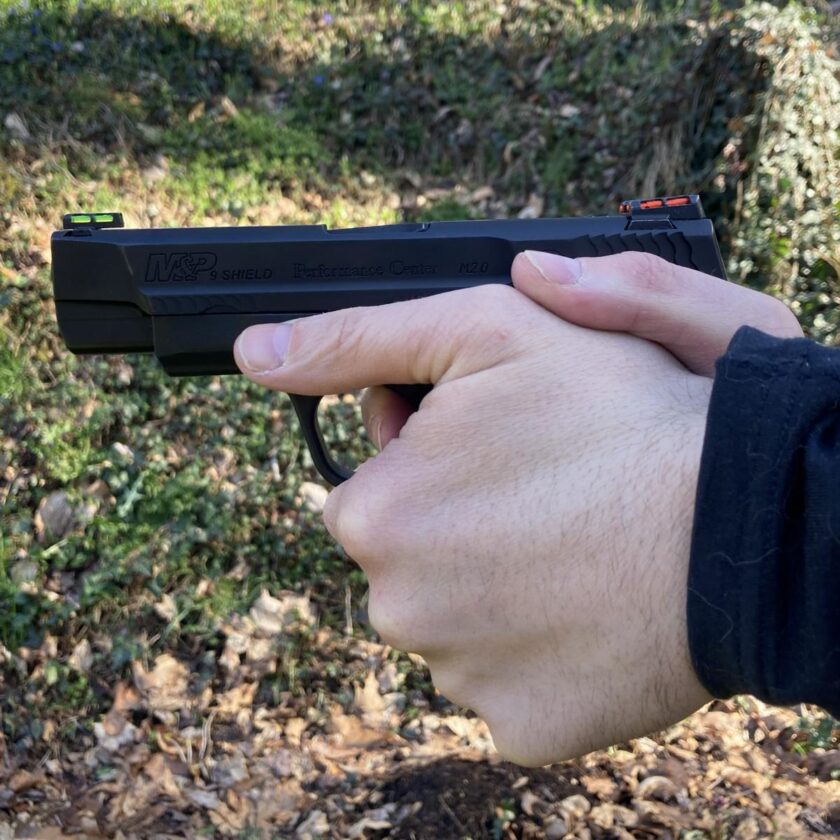
The dimensions of this pistol are very unique. First, it’s exactly as flat as an M&P Shield. With a flush-fit magazine the butt of the gun is as short as a Shield, and much shorter than the mid-sized M&P9 Compact. However, the barrel is longer than the compact, double-stack 9mm and almost as long as the 4.25″ tube of the full-sized M&P.
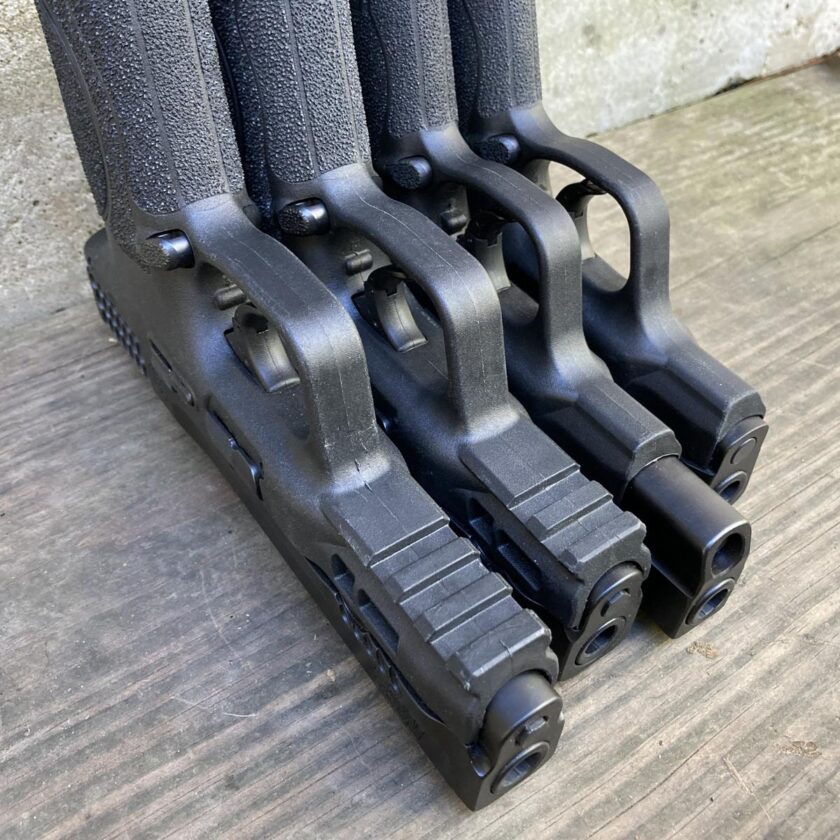
Shooting the Long-Slide Shield
Unfortunately I didn’t get to shoot this gun quite as much as I would have liked to. That probably shouldn’t come as a huge surprise considering the ongoing run on ammo. Fortunately I was smart enough to lay in a good bit of ammo starting several years ago, so I was able to put a few hundred rounds through this particular pistol. I consider the Shield to be thoroughly debugged technology. It is one of the most popular pistols on the market and among the attributes that make it so popular is reliability. I don’t feel like I have to put 3,000 malfunction-free rounds through a Shield to consider it reliable.
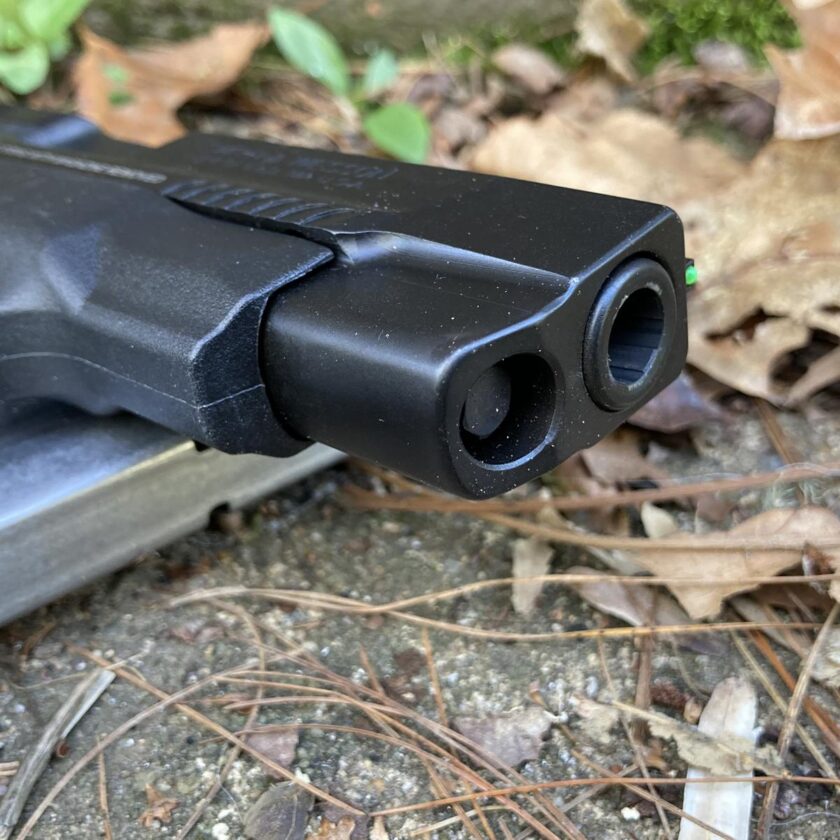
However, I do tend to treat every gun as an individual where reliability is concerned. As I’ve related several times in these pages, I bought a Glock 19 in December of 2019 (the third G19 and fifth Glock I’ve owned). Despite the tremendous reputation of Glock, it malfunctioned twice with high-quality, factory ammo in the first 100 rounds. Secondly, this gun (like the Gen5 G19) is a modified version of the original platform, so I don’t trust it quite as much as I’d trust a standard Shield.
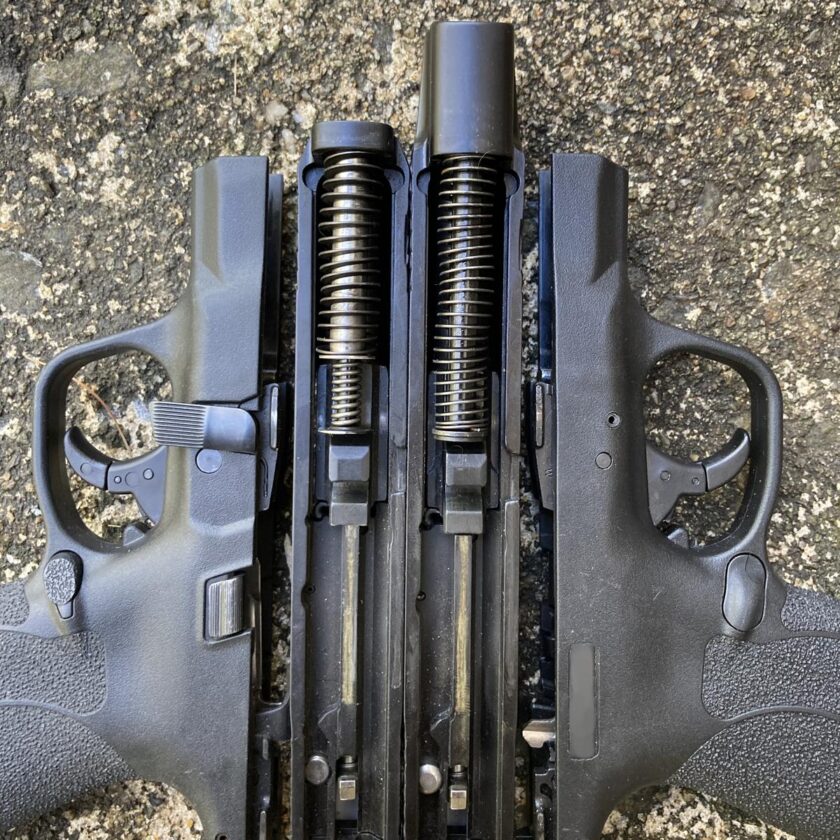
Let’s look a a few takeaways from my range sessions with the new Shield.
Reliability
I was not disappointed by the long-slide Shield. I fired 295 rounds (again, not as much as I’d like) without the first hint of a failure. The Shield chewed everything up and spit it out with aplomb. If I were going to turn this into my daily carry gun I would feel a lot more comfortable once I had 1,000 or so malfunction-free rounds through it. Still, I feel pretty comfortable with this gun’s reliability; it is a Shield, after all. After almost 300 rounds I felt good enough to carry this gun as my daily-carry pistol for a couple of weeks, and I’ll talk about that a bit more later.
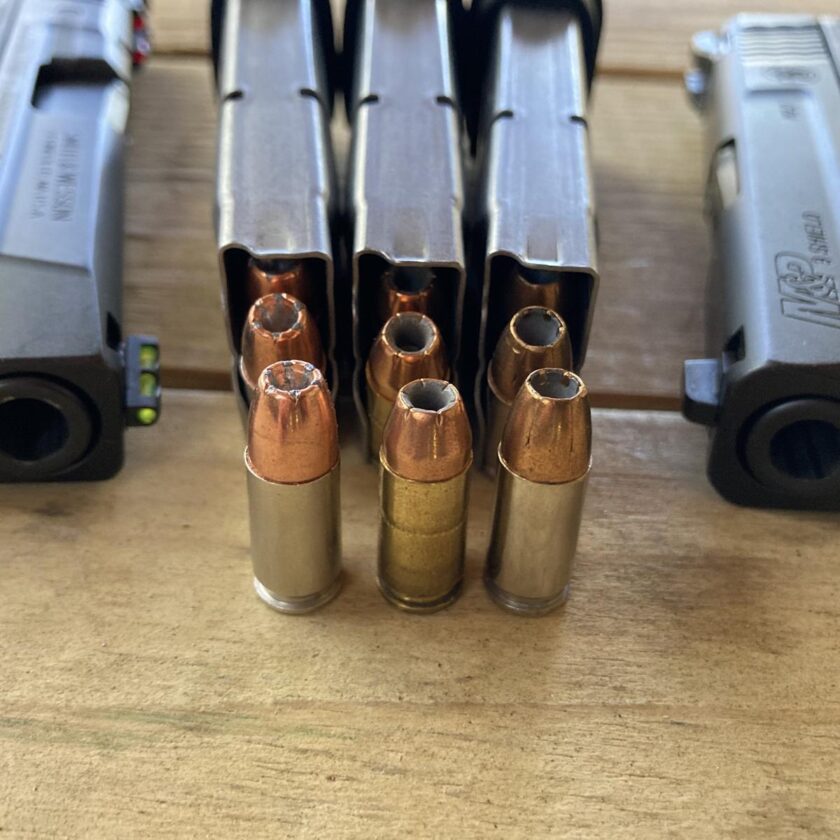
Most of the ammunition I fired was S&B 124-grain ball. I also fired 60 rounds of Federal 124-grain +P HST to verify reliability before I actually carried the long-slide Shield. Finally, I few rounds each of Speer 124-grain +P Gold Dot and some old Cor-Bon 125-grain +P JHP that I had lying around. I shot these over a chronograph, as you’ll see a little further down.
Accuracy
In all four of my range sessions with this gun I did a little bit of side-by-side shooting with my standard, 2.0 M&P. I had hoped to do a detailed comparison between to the two, including some a true accuracy comparison. Ammo availability and time availability conspired to put a great, objective comparison out of reach for me so you’ll have to rely on my “feels.” To be honest, the difference with the long-slide Shield wasn’t quite as big as I might have imagined it would be. Both my Shield and the loaner long-slide Shield are tremendously accurate pistols. With both I was capable of small (say, under 6″) groups from offhand at 25 yards.
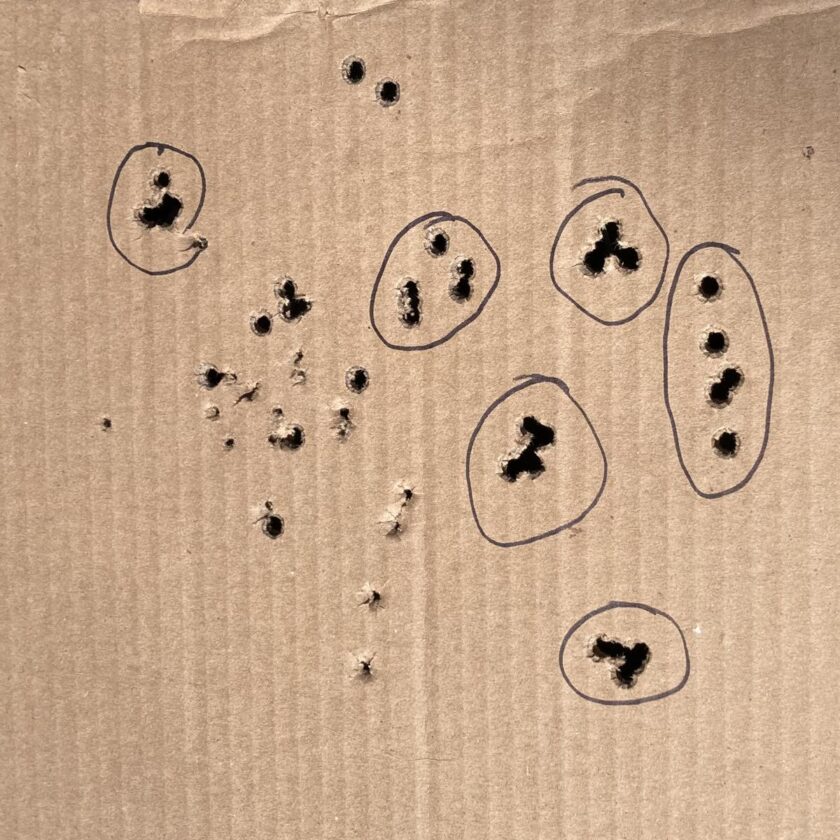
The longer Shield, while not producing substantially smaller groups, did perhaps have some other benefits. I found that shooting it accurately was just a bit easier – it just wasn’t quite as hard to hit well with at 25. It also might have been a bit faster – the shot just seemed to come together faster. Again, I lacked the ammo to do a really great comparison and offer you hard numbers, but I did feel that the long-slide Shield gave me just a slight edge.
Shootability
Nothing is more subjective or harder to describe and differentiate than recoil. I’m sure there is some mild recoil difference between the long- and standard-slide Shields. I’m not prepared to make that comparison or to make a case for one or the other. Both of these are fantastic pistols that shoot extremely well. When shooting both it was easy to forget I was shooting a sub-compact micro-nine because both handle recoil so well and both shoot so well.
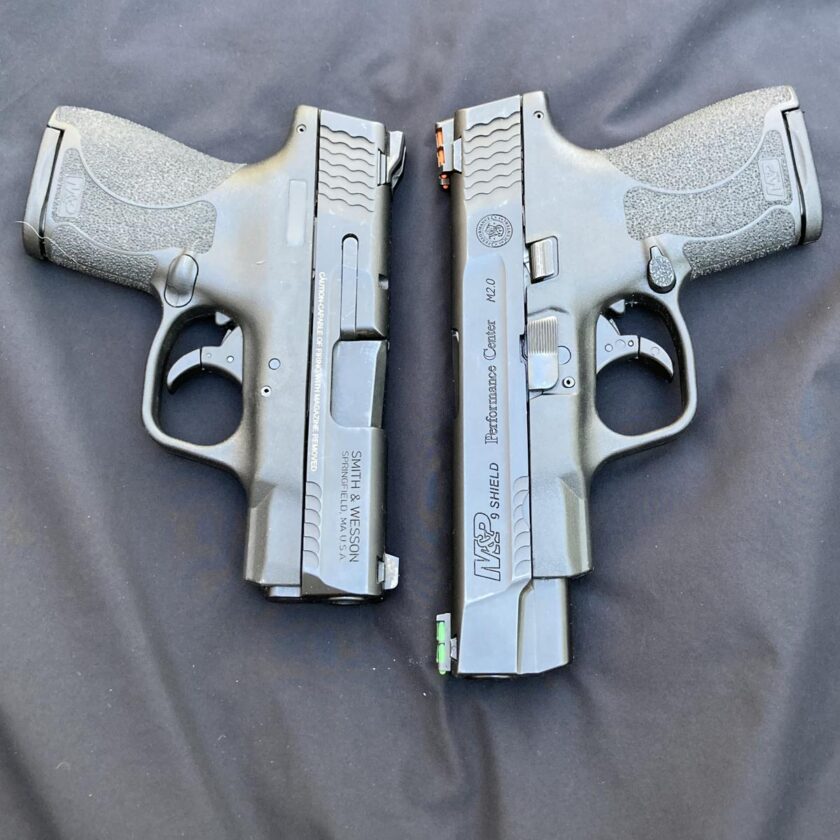
All in all I found the long-slide shield to be incredibly shootable. Recoil was, if not mild, at least very manageable. It is plenty accurate. It’s as boringly reliable as a Singer sewing machine. I really enjoyed my range time with the long-slide Shield, and I wished for more.
Velocity
Here is where we get into something that I can back up with actual hard numbers. How much these numbers matter is probably debatable, but some of you will certainly find them interesting. I chronographed three different JHP loads in each gun. Rather than eat a bunch of space with the full results, here are the averages:
| 3.1" Shield | 4.0" Shield |
|---|---|
| Speer Gold Dot: 1099 | Speer Gold Dot: 1149 |
| Fed HST: 1,110 | Fed HST: 1,154 |
| Cor-Bon JHP: 1,237 | Cor-Bon JHP: 1,278 |
| AVG: 1145 FPS | AVG: 1194 FPS |
Now, what does that information mean? Honestly, I don’t know that it means all that much. An average difference of 49 FPS (or 50 with my chosen load, the Federal 124-grain +P HST) isn’t all that much. Then again, the 3.1″ Shield is producing pretty low-end velocities that might be on margins of a bullet’s performance envelope. I’d take any help I could get. But I wouldn’t choose this gun just for that. Bullet performance matters far less than bullet placement and is probably a factor in a fight’s outcome only rarely. Again though, since the boost is part of the bargain, I’ll take it!
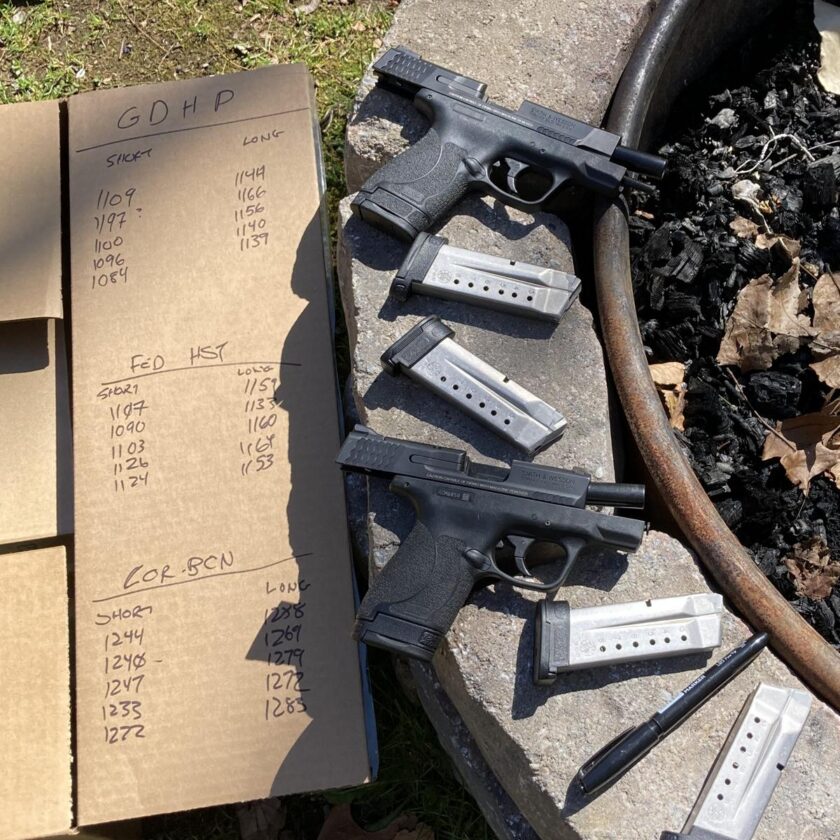
Conducting my backyard chrono session. I love where I live.
So…?
At this point you might be wondering, “so what? Why carry the longer gun?” It’s a fair question because the answers aren’t perfectly clear. First, I wasn’t able to demonstrate a huge increase in accuracy or speed with the longer pistol. I wasn’t able to objectively differentiate between the recoil of the two – the bigger one might have less recoil, or my biases could be influencing my perceptions. The velocity issue is barely there – a mere 50 FPS difference between the two pistols. This might make a slight difference in hollowpoint performance since the standard 3.1″ Shield barrel probably produces marginal velocities, but I wouldn’t hang my hat on it. So why carry the bigger gun?
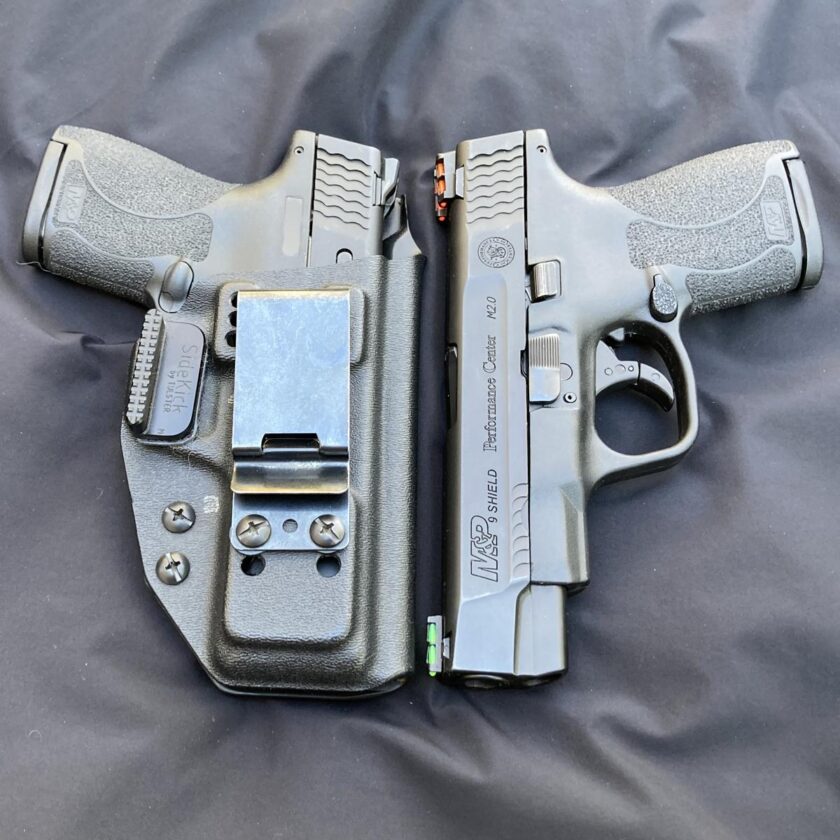
Here is one objective reason: space on the slide. The longer Shield gives you a bit more to work with on the slide. Whether press-checking, clearing malfunctions, or whatever, the standard Shield doesn’t have a lot of room to work with, even for a guy with small hands like me. In fact I’ve “muzzled” my own hand clearing (self-induced) malfunctions with the short Shield. The longer Shield definitely offers a bit more space to work with, and just a tad more margin for error.
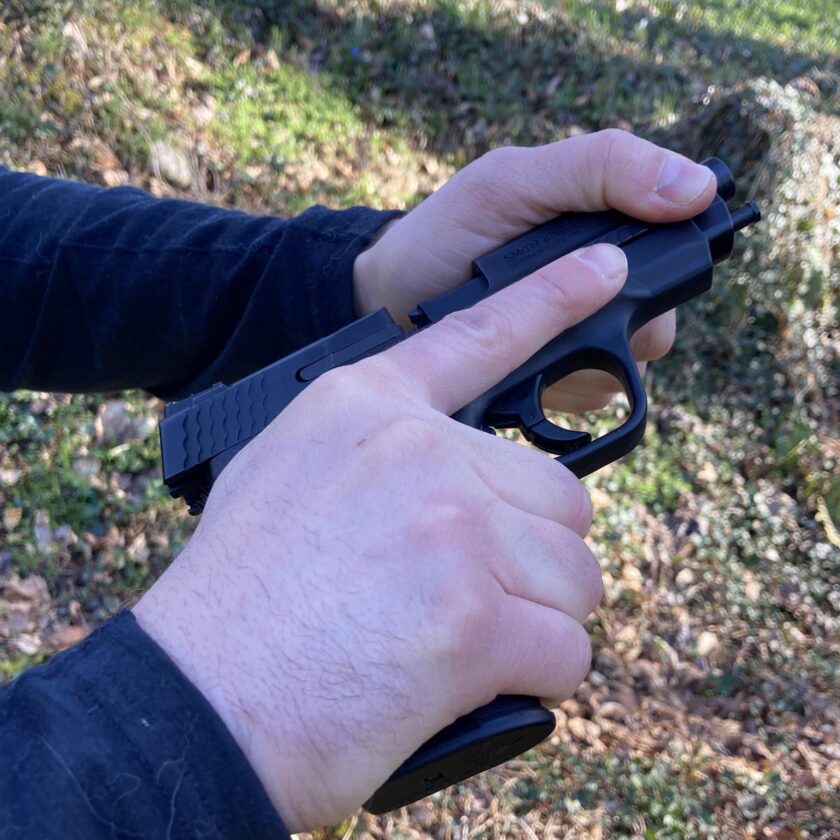
Secondly, there is certainly a subjective benefit here, at least to me: this gun “handles” like a real gun. I seemed to have an easier time coming up on target. It felt more balanced and honestly just felt more like a “real” pistol. I get it – subjectivity only counts to me. I wouldn’t recommend you buy a pistol based on my subjective feelings, but it might be worth your time to explore the long-slide variants of the Shield family.
Carrying the Long-Slide Shield
Maybe I shouldn’t have been, but after 295 rounds I was comfortable carrying the long-slide Shield. This was based not only on those few rounds, but also the totality of my experience with the M&P line.The appeal of guns like the Shield is how damn easy they are to carry. It’s very easy to carry a gun that will fit in the palm of your hand. Lots of pistols prior to the Shield carried easily, but none shot quite like the Shield, which shoots like a “real” pistol.
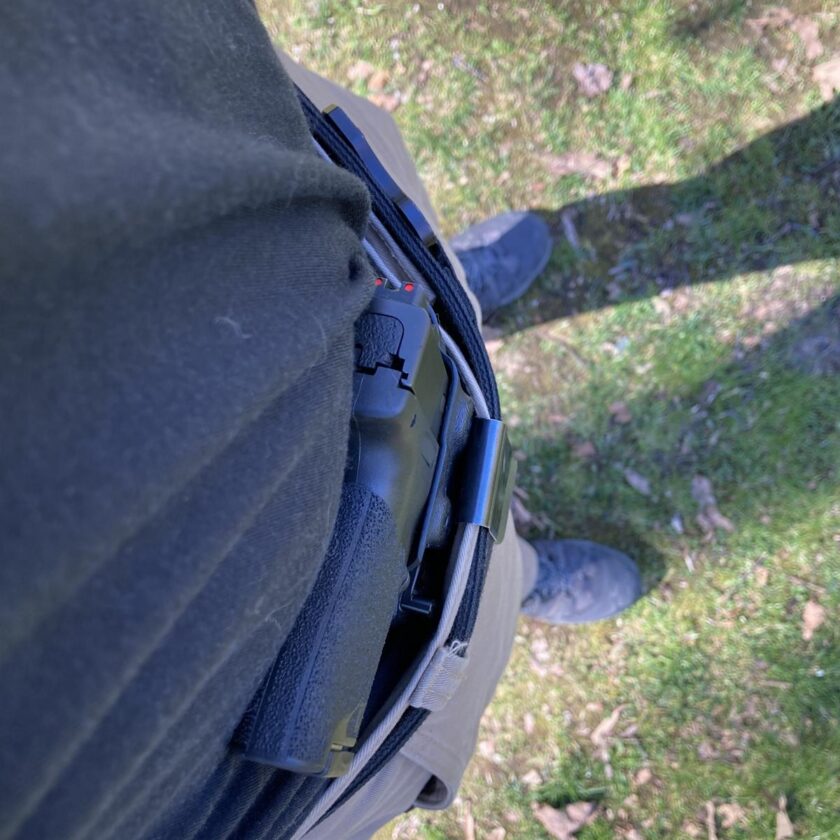
When I asked to borrow this gun from S&W I sincerely hoped that it would fit in my Dark Star Gear Hitchhiker holster. I used this holster to carry my standard Shield and really loved it, but was annoyed by the extra space in at the end of the holster. Appendix holsters are frequently built a bit longer than the guns they hold because the extra length helps keep them rotated in to the body. I was extremely relieved when this gun arrived, I slid it into the Dark Star Gear holster, and it fit like a glove. This saved me the time and expense of finding a holster, and ensured I could give this gun a fair test right off the bat. It also validated a thought I’d had for a long time: if there’s extra space in the holster, why not fill it with some extra slide and barrel?
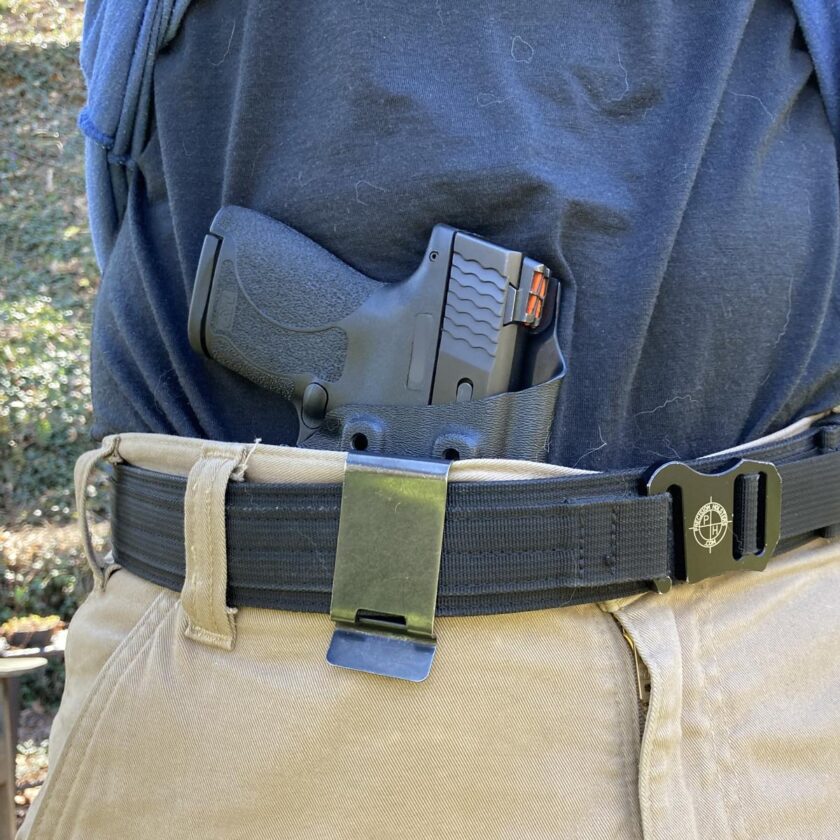
Now, the longer Shield might not be best for everyone. It won’t conceal as well in a pocket or some other unconventional styles of carry. On the belt, though, concealing an extra inch of barrel is rarely an issue. I did several range sessions with this combination before carrying it. My range sessions were intended to test the gun, but did double-duty in getting me comfortable enough with it to feel confident carrying it.
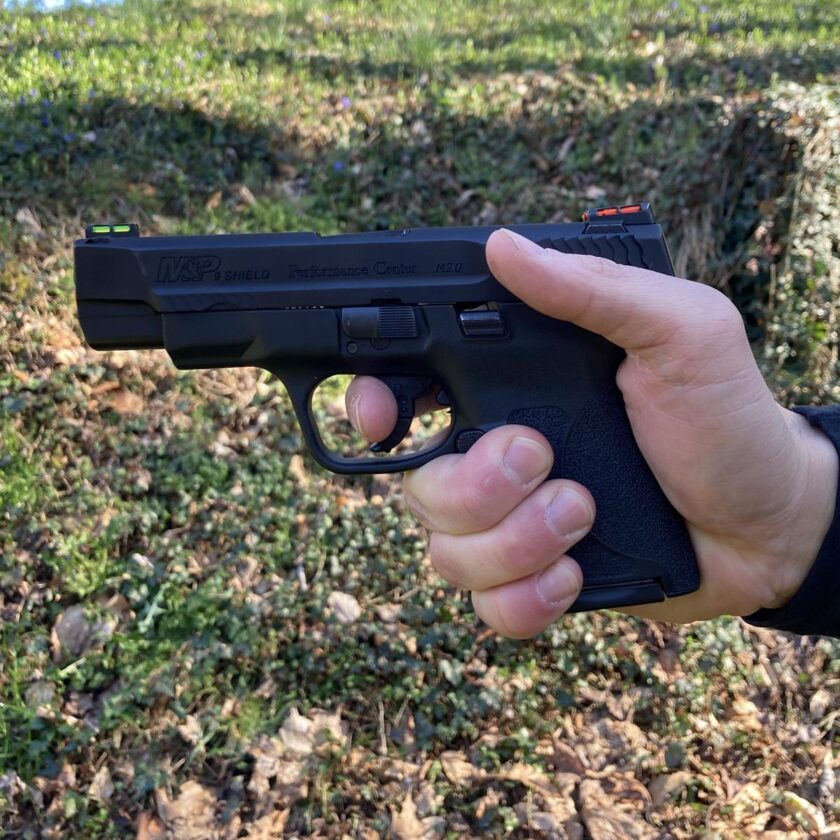
I found that I was most comfortable carrying this pistol with the 7-round magazine in place. With the longer, 8-round magazine I just couldn’t quite keep the gun from printing. Though some do, I have no issue at all with the standard 7-round, flush-fit magazines. I can still get all four fingers on the gun. That said, I’d rather have eight rounds than seven, and I found reloading easier with the longer magazines. I don’t appreciate the tendency of the mag sleeve to slip down, so I replaced the base plates on two mags with MagFix base plates. These aftermarket parts feature a new sleeve that is locked in place and prevented from riding up the magazine. Though they double the cost of a magazine, I think it’s worth having one if you’re carrying a spare mag with your Shield.
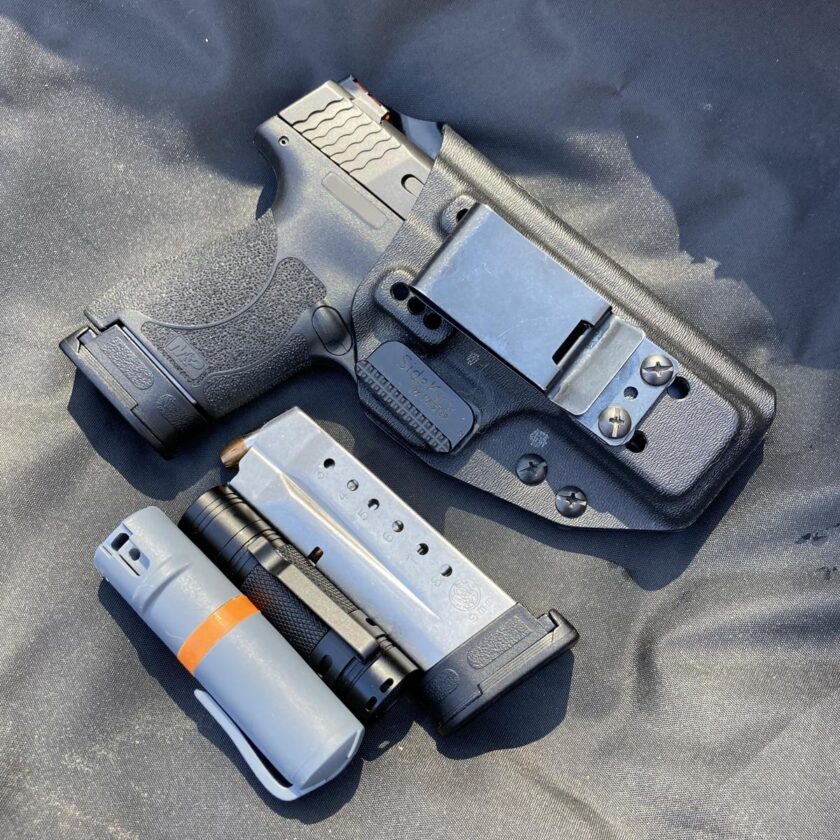
With all that out of the way, how was carrying the long-slide Shield? In short: it was great. It’s just as flat as its little brother; in the holster you honestly can’t tell which Shield you’re carrying. The grip frame is short and easy to hide – it’s much shorter than the G19-sized M&P9 Compact. But the barrel is long – almost as long as the full sized M&P pistol. It’s a small gun that handles and shoots like a big gun. Which is exactly what I want in a carry gun: something that downplays itself in the holster but punches above its weight class in the hand. I would have no problem carrying this pistol on a daily basis.
Closing Thoughts
I kind of feel that I failed in this article, in two ways. First, it was my intent to come up with some demonstrable, quantifiable difference between the 3.1″ and 4.0″ barreled Shields. Ammo availability and my limited time conspired to prevent that from happening. Secondly, in taking so long to get this review done I let another, even more impressive Shield come along and steal the thunder of a mere 7+1 pistol review (maybe I’ll review a Shield Plus soon – who knows? I’m definitely going to bug S&W about it. If so I promise I’ll spend the ammo to get a decent picture of reliability).
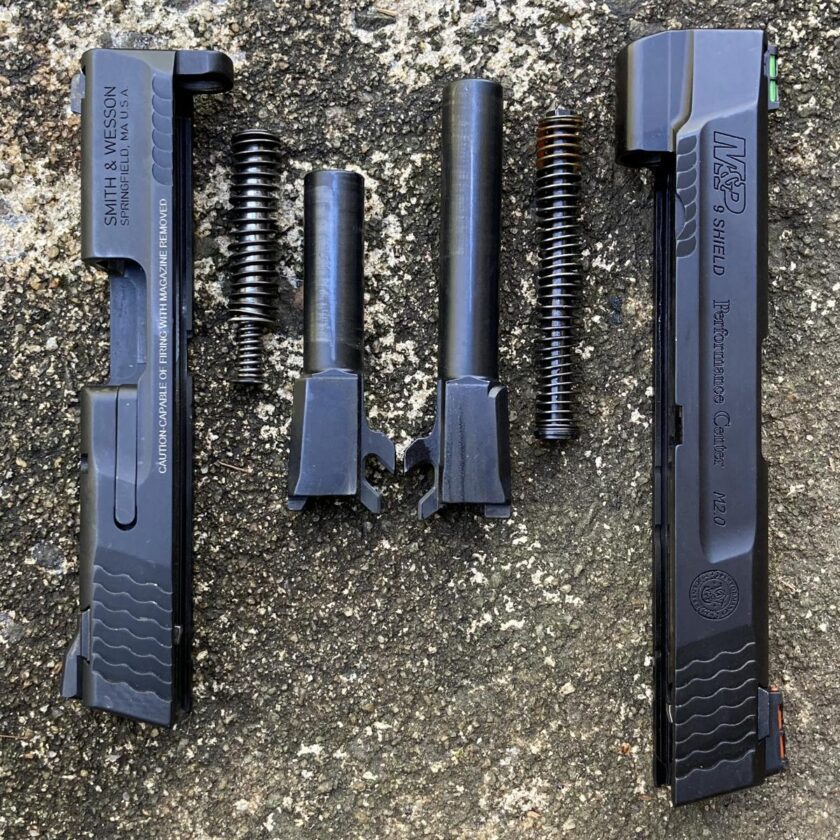
But I was also successful in a way I didn’t expect. This review got me reacquainted with a pistol that I often overlook. I admit that my Shield sometimes seems to just be “in the way” in the safe. Though I didn’t prove the long-nosed Shield to be massively better than the standard Shield, I learned that both are fabulous carry pistols. Ultimately, though, if I were going to carry a Shield it would be the long-slide version. Though overlooked (I’ve never seen one on a gun store shelf) I do believe this is the best Shield. At just $65 over MSRP for a standard, non-PC Shield I think the price difference is well worth it, and it would be well worth your time to check this pistol out.
†I swear, I’m not just saying all that to justify reviewing a 7+1 gun when a 10+1 pistol fits in the same holster! Or maybe I am a little bit, but still, this is an outstanding little pistol.





